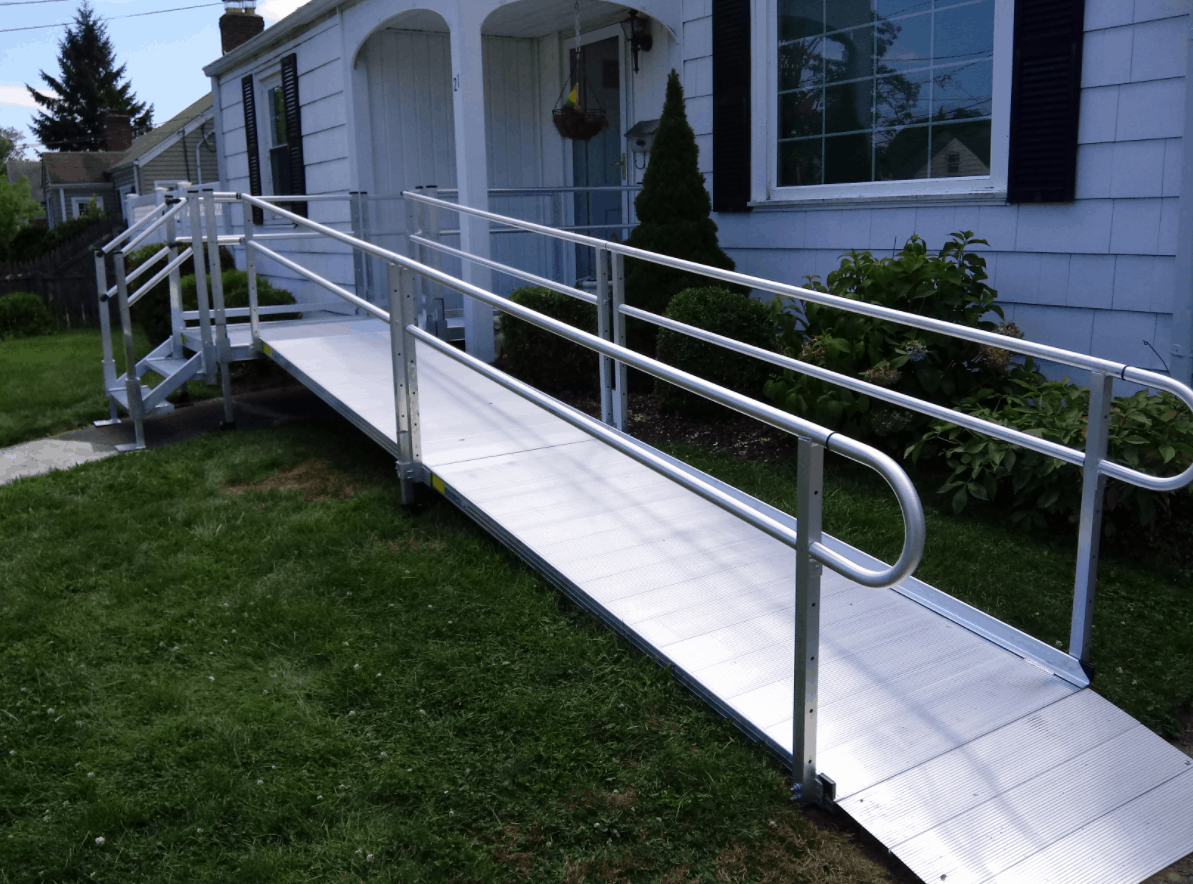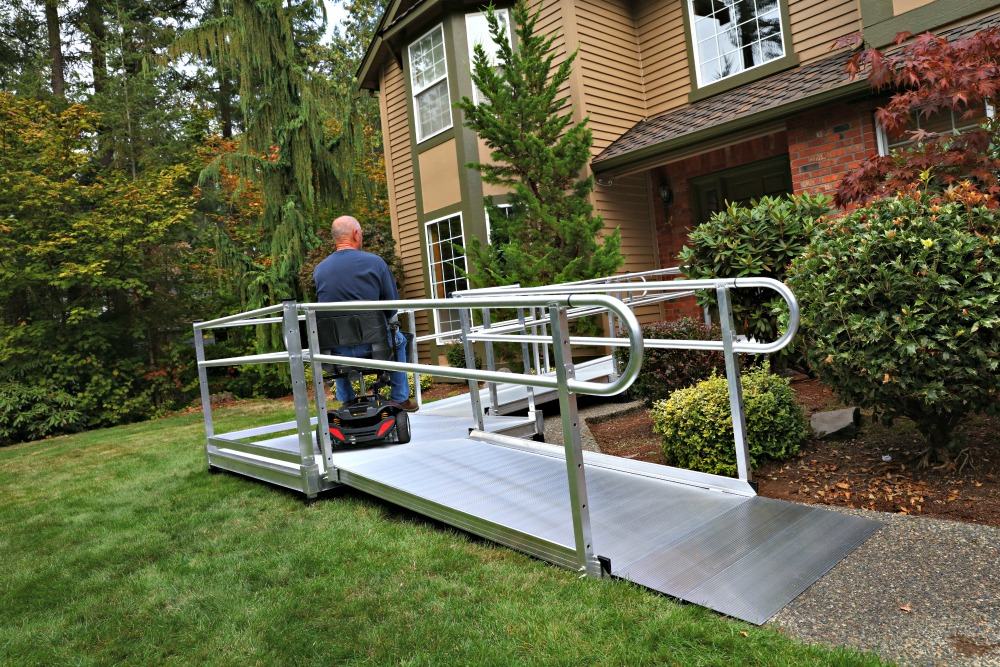Wheelchair Ramp or Vertical Platform Lift: Which is Right for You?
Posted on by John Burfield
More than 3 million Americans use a wheelchair and over 10 million use some other form of walking aid, according to statistics. If you have limited mobility and require the use of a mobility aid such as a wheelchair, scooter, or walker, you’d likely benefit from having a ramp or vertical platform wheelchair lift (VPL) installed in your home.
A wheelchair ramp is designed to replace stairs. Ramps can be modified to fit any need, from a short ramp that gets you from the garage into your home, to a long ramp that helps you access the outside.
Platform lifts act like elevators, raising and lowering a person from one level to another. They are much smaller than elevators, of course, and can be modified to be open or enclosed.
Although wheelchair ramps are still common in many areas, wheelchair lifts, more specifically vertical platform lifts (VPLs), have become the primary method of access that many wheelchair users living in densely populated urban areas and cities rely on for entry and exit from their homes.
When trying to decide between the two, there are many factors to consider. In this post, we'll help you learn more about accessible solutions so that you can better understand whether a wheelchair or ramp is going to be the better option for you.


Wheelchair Ramps
Ideally, a ramp should have a 1:12 slope ratio or one foot of length for every inch of rise. If you have limited space, which is the case with many urban homes, you may not have enough room to construct a ramp that is the proper slope. For example, a ramp built to accommodate a rise of four feet would need to be 48 feet long. This is a situation where a wheelchair lift would be the right solution.

Wheelchair Lifts (Vertical Platform Lift)
While most people are familiar with residential ramps, a vertical platform wheelchair lift (VPL) in a home setting is less common. However, you may have seen them in public spaces such as restaurants and churches.
 A VPL is basically a mini elevator that consists of an approximate 3' by 4' platform, with 2 sidewalls, an automatic self-lowering folding ramp, and a gate at the top that can lift 750 lbs. up to 14 feet. They are sometimes referred to as porch lifts since they are often found connected to a porch, stoop, or deck.
A VPL is basically a mini elevator that consists of an approximate 3' by 4' platform, with 2 sidewalls, an automatic self-lowering folding ramp, and a gate at the top that can lift 750 lbs. up to 14 feet. They are sometimes referred to as porch lifts since they are often found connected to a porch, stoop, or deck.
Starting price for a VPL that rises between 4' to 6' is typically about $7,500 with installation. However, final cost depends on the amount of prep work (concrete pads, deck renovation, etc.), lifting height, and the lift make and model. While ramps are sometimes the more cost-effective solution (a 10-foot aluminum modular ramp with handrails starts at $2,000), there are situations where they simply won’t work.
Location of Installation for a Ramp or Wheelchair Lift
Wheelchair lifts can handle harsh outdoor climates, but many people will have them installed in their garage. This keeps the individual and their caregiver out of the elements and takes up less space than a ramp, allowing for more storage in the garage.
 The compact size of a VPL makes them ideal for people that have limited space. However, even if you have the space required for a code compliant wheelchair ramp, a VPL may be the better choice for your lifestyle.
The compact size of a VPL makes them ideal for people that have limited space. However, even if you have the space required for a code compliant wheelchair ramp, a VPL may be the better choice for your lifestyle.
VPLs are safe and easy to use and can be more aesthetically pleasing than a large ramp system. Larger ramps will also have a price tag that is more comparable to a VPL. If the rise to step is 32' or higher, it may actually be more cost-effective to install a VPL.
While ramps will be the right solution for many people with limited mobility, the advantages of a vertical platform lift are making them a popular choice when space is limited in urban settings across America.
Things to Consider when Choosing Between a Ramp and a VPL
- Purpose: Why do you need the ramp or lift? Some may need easier access to an upper level in their home, while others need an easier way to get in and out of the house.
- Aesthetics: Ramps can be bulky and longer ones will have twists and turns. They are usually made of materials that are sturdy but may need to be maintained if they are in the weather full-time. Elevators have a modern, sleek appeal that holds up over time.
- Ease of Use: Both wheelchair ramps and platform lifts are relatively simple to use. Lifts are considered easier due to it being operated with the touch of a button. Ramps require you to do all the work.
- Portability: Both wheelchair ramps and platform lifts can be made in portable versions. The platform lift does come in a portable model, but it is bulky and would be impossible for one person to move it from one location to another. Portable wheelchair ramps are small, and many are easy to move around.
- Length of time needed: Do you need an easier way to get into your home as you recover from an illness, or do you have a permanent condition that will require a mobility device for as long as you will stay in your home? If you will only need mobility assistance temporarily, the portable wheelchair ramp is your best bet. If you will need the device for a long time, or a lifetime, the platform lift may be the best option.
- Cost: Both wheelchair ramps and platform lifts can be costly, depending on the size and style you choose. Don’t let cost be the first factor you consider. Weigh the pros and cons of both the wheelchair ramp and the platform lift to see which product will serve you best for the longest amount of time.
Do you still have questions about which is right for you? Most reputable home access professionals will provide a free in-home consultation. Contact us to set up a free consultation with a Lifeway accessibility expert.
